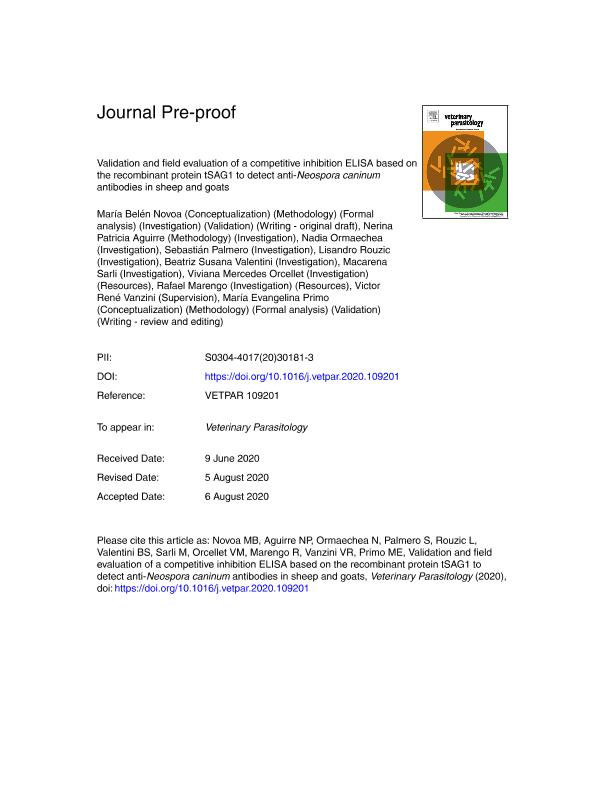Mostrar el registro sencillo del ítem
dc.contributor.author
Novoa, María Belén

dc.contributor.author
Aguirre, Nerina Patricia
dc.contributor.author
Ormaechea, Nadia
dc.contributor.author
Palmero, Sebastián
dc.contributor.author
Rouzic, Lisandro
dc.contributor.author
Valentini, Beatriz Susana

dc.contributor.author
Sarli, Macarena

dc.contributor.author
Orcellet, Viviana Mercedes

dc.contributor.author
Marengo, Rafael
dc.contributor.author
Vanzini, Victor René
dc.contributor.author
Primo, Maria Evangelina

dc.date.available
2023-01-13T14:37:56Z
dc.date.issued
2020-08
dc.identifier.citation
Novoa, María Belén; Aguirre, Nerina Patricia; Ormaechea, Nadia; Palmero, Sebastián; Rouzic, Lisandro; et al.; Validation and field evaluation of a competitive inhibition ELISA based on the recombinant protein tSAG1 to detect anti-Neospora caninum antibodies in sheep and goats; Elsevier Science; Veterinary Parasitology; 284; 8-2020; 1-6
dc.identifier.issn
0304-4017
dc.identifier.uri
http://hdl.handle.net/11336/184686
dc.description.abstract
Neospora caninum is a protozoan parasite that causes abortion and reproductive failure in small ruminants. We validated and evaluated under field conditions a competitive inhibition ELISA based on the truncated SAG1 protein (tSAG1) from N. caninum for the detection of anti-N. caninum antibodies in sheep and goat flocks. The assay was validated using 80 positive and 142 negative serum samples from sheep and goats analyzed by IFAT and immunoblot (IB). ciELISAtSAG1 was then used to evaluate the prevalence of anti-N. caninum antibodies in 1449 goats from 143 flocks and 385 sheep from 40 flocks and compared to IFAT. The prevalence of anti-Toxoplasma gondii antibodies was evaluated by IFAT. The ciELISAtSAG1 cut-off was ≥ 36 percent inhibition, with a diagnostic sensitivity of 100.0 % (95 % CI = 95.4–100.0 %) and a diagnostic specificity of 98.6 % (95 % CI = 95.0–99.8 %) relative to the agreement between IFAT and IB. The field evaluation revealed a concordance between ciELISAtSAG1 and IFAT of 97.4 %, with an agreement (κ) of 0.90 for sheep sera, and a concordance of 96.5 % with κ = 0.85 for goat sera. The overall prevalence of anti-N. caninum antibodies in sheep was 14.3 % by IFAT and 15.8 % by ciELISAtSAG1. In goats, prevalence was 12.9 % by IFAT and 14.6 % by ciELISAtSAG1. The overall prevalence of anti-T. gondii antibodies was 28.8 % in goats and 43.8 % in sheep. The ciELISAtSAG1 could be useful for large-scale detection of anti-N. caninum antibodies in sheep and goats, and for seroepidemiological investigations due to its appropriate sensitivity and specificity, and the simplicity of production.
dc.format
application/pdf
dc.language.iso
eng
dc.publisher
Elsevier Science

dc.rights
info:eu-repo/semantics/openAccess
dc.rights.uri
https://creativecommons.org/licenses/by-nc-sa/2.5/ar/
dc.subject
CIELISA
dc.subject
DIAGNOSIS
dc.subject
GOAT
dc.subject
N. CANINUM
dc.subject
PREVALENCE
dc.subject
SAG1
dc.subject
SHEEP
dc.subject
T. GONDII
dc.subject.classification
Ciencias Veterinarias

dc.subject.classification
Ciencias Veterinarias

dc.subject.classification
CIENCIAS AGRÍCOLAS

dc.title
Validation and field evaluation of a competitive inhibition ELISA based on the recombinant protein tSAG1 to detect anti-Neospora caninum antibodies in sheep and goats
dc.type
info:eu-repo/semantics/article
dc.type
info:ar-repo/semantics/artículo
dc.type
info:eu-repo/semantics/publishedVersion
dc.date.updated
2022-09-22T15:10:45Z
dc.journal.volume
284
dc.journal.pagination
1-6
dc.journal.pais
Países Bajos

dc.journal.ciudad
Amsterdam
dc.description.fil
Fil: Novoa, María Belén. Consejo Nacional de Investigaciones Científicas y Técnicas; Argentina. Instituto Nacional de Tecnología Agropecuaria. Centro Regional Santa Fe. Estación Experimental Agropecuaria Rafaela; Argentina
dc.description.fil
Fil: Aguirre, Nerina Patricia. Instituto Nacional de Tecnología Agropecuaria. Centro Regional Santa Fe. Estación Experimental Agropecuaria Rafaela; Argentina
dc.description.fil
Fil: Ormaechea, Nadia. Universidad Nacional del Litoral; Argentina
dc.description.fil
Fil: Palmero, Sebastián. Universidad Nacional del Litoral; Argentina
dc.description.fil
Fil: Rouzic, Lisandro. Universidad Nacional del Litoral; Argentina
dc.description.fil
Fil: Valentini, Beatriz Susana. Instituto Nacional de Tecnología Agropecuaria. Centro Regional Santa Fe. Estación Experimental Agropecuaria Rafaela; Argentina
dc.description.fil
Fil: Sarli, Macarena. Instituto Nacional de Tecnología Agropecuaria. Centro Regional Santa Fe. Estación Experimental Agropecuaria Rafaela; Argentina. Consejo Nacional de Investigaciones Científicas y Técnicas; Argentina
dc.description.fil
Fil: Orcellet, Viviana Mercedes. Universidad Nacional del Litoral; Argentina
dc.description.fil
Fil: Marengo, Rafael. Consejo Nacional de Investigaciones Científicas y Técnicas; Argentina
dc.description.fil
Fil: Vanzini, Victor René. Instituto Nacional de Tecnología Agropecuaria. Centro Regional Santa Fe. Estación Experimental Agropecuaria Rafaela; Argentina
dc.description.fil
Fil: Primo, Maria Evangelina. Instituto Nacional de Tecnología Agropecuaria. Centro Regional Santa Fe. Estación Experimental Agropecuaria Rafaela; Argentina. Consejo Nacional de Investigaciones Científicas y Técnicas. Centro Científico Tecnológico Conicet - Santa Fe. Instituto de Investigación de la Cadena Láctea. - Instituto Nacional de Tecnología Agropecuaria. Centro Regional Santa Fe. Estación Experimental Agropecuaria Rafaela. Instituto de Investigación de la Cadena Láctea; Argentina
dc.journal.title
Veterinary Parasitology

dc.relation.alternativeid
info:eu-repo/semantics/altIdentifier/url/https://linkinghub.elsevier.com/retrieve/pii/S0304401720301813
dc.relation.alternativeid
info:eu-repo/semantics/altIdentifier/doi/http://dx.doi.org/10.1016/j.vetpar.2020.109201
Archivos asociados
